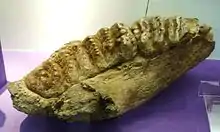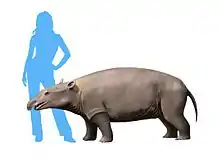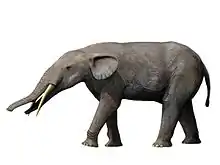Stegolophodon
Stegolophodon is an extinct genus of stegodontid proboscideans, with two tusks and a trunk. It lived during the Miocene and Pliocene epochs,[1][2][3][4][5] and may have evolved into Stegodon. Fossils have been primarily found in Asia, but some have also been reported in Africa.[6]

S. cautleyi
| Stegolophodon | |
|---|---|
 | |
| Tooth of Stegolophodon latidens | |
| Scientific classification | |
| Kingdom: | Animalia |
| Phylum: | Chordata |
| Class: | Mammalia |
| Order: | Proboscidea |
| Family: | †Stegodontidae Schlesinger, 1917 |
| Genus: | †Stegolophodon |
| Type species | |
| †Stegolophodon latidens (Clift, 1828) (originally Mastodon latidens) | |
| Species | |
| |
References
- Suga, Shoichi; Nakahara, Hiroshi (2012-12-06). Mechanisms and Phylogeny of Mineralization in Biological Systems: Biomineralization '90. Springer Science & Business Media. ISBN 9784431681328.
- Youping Zhang, Yuzhu Long, Hongxiang Ji, Suyin Ding, Translated by Will Downs Bilby Research Center, Northern Arizona University March (November 1999) [1989]. "The Cenozoic Deposits of the Yunnnan Region" (PDF). Professional Papers on Stratigraphy and Paleontology No. 7, Geological Publishing House, Peking, China, Pp. 1-21.CS1 maint: multiple names: authors list (link)
- Geer, Alexandra van der; Lyras, George; Vos, John de; Dermitzakis, Michael (2011-02-14). Evolution of Island Mammals: Adaptation and Extinction of Placental Mammals on Islands. John Wiley & Sons. ISBN 9781444391282.
- "The first mariners | AURANET". www.ifrao.com. Retrieved 2016-06-11.
- "Fossilworks: Stegolophodon". fossilworks.org. Retrieved 2016-06-11.
- Maguire, Kaitlin (November 2010). "The Stegodontidae". University of California Museum of Paleontology.
This article is issued from Wikipedia. The text is licensed under Creative Commons - Attribution - Sharealike. Additional terms may apply for the media files.


